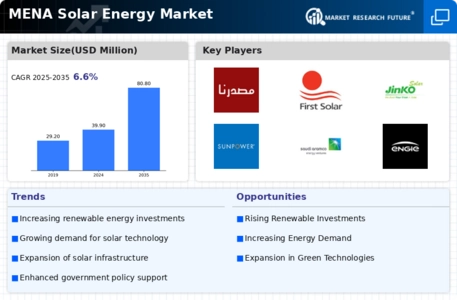Market Share
MENA Solar Energy Market Share Analysis
In the dynamic landscape of the MENA (Middle East and North Africa) Solar Energy Market, companies employ various strategies to carve out their market share. One prevalent approach is differentiation, where companies seek to distinguish their offerings from competitors through unique features or benefits. For instance, some companies may focus on providing solar panels with higher efficiency or greater durability, while others may emphasize affordability or ease of installation. By highlighting these distinctive qualities, companies can attract specific customer segments and establish a loyal customer base.
Another strategy commonly employed in the MENA Solar Energy Market is cost leadership. Given the increasing demand for renewable energy solutions in the region, companies often compete based on price to capture market share. This involves streamlining operations, optimizing supply chains, and leveraging economies of scale to lower production costs. By offering competitive prices, companies can appeal to price-sensitive customers and gain an edge over rivals. Additionally, cost leadership can help companies penetrate emerging markets or expand their reach within existing markets.
Moreover, market segmentation plays a crucial role in market share positioning strategies. Companies identify different customer segments based on factors such as geographical location, industry vertical, or consumer preferences. By tailoring their products and marketing efforts to specific segments, companies can effectively address the unique needs and demands of diverse customer groups. For example, companies may develop specialized solar solutions for residential, commercial, or industrial applications, each catering to distinct customer requirements. By segmenting the market, companies can maximize their market share by catering to a wide range of customers effectively.
Furthermore, strategic partnerships and alliances are instrumental in gaining market share in the MENA Solar Energy Market. Collaborating with other industry players, government agencies, or technology providers can provide companies with access to new markets, resources, and expertise. For instance, companies may form strategic partnerships with local distributors or installers to expand their market reach and enhance customer service. Likewise, collaborations with research institutions or universities can facilitate technology innovation and product development, giving companies a competitive advantage in the market.
In addition to these strategies, branding and reputation management are vital for market share positioning in the MENA Solar Energy Market. Establishing a strong brand identity and cultivating a positive reputation can significantly influence consumer perception and purchasing decisions. Companies invest in building brand awareness, fostering customer trust, and maintaining a positive image through various marketing channels and communication platforms. By effectively communicating their value proposition and commitment to quality and sustainability, companies can differentiate themselves from competitors and capture a larger share of the market.
Furthermore, continuous innovation and technological advancements are key drivers of market share growth in the MENA Solar Energy Market. Companies invest in research and development to improve existing products, develop new technologies, and stay ahead of evolving market trends. By introducing innovative solutions that offer superior performance, efficiency, or functionality, companies can attract tech-savvy customers and gain a competitive edge in the market. Additionally, staying abreast of technological advancements enables companies to adapt to changing customer needs and preferences, ensuring long-term success and market leadership.
Market share positioning strategies in the MENA Solar Energy Market encompass a diverse range of approaches, including differentiation, cost leadership, market segmentation, strategic partnerships, branding, and innovation. By leveraging these strategies effectively, companies can enhance their competitive position, expand their market presence, and capitalize on the growing demand for renewable energy solutions in the region. With a focus on customer-centricity, innovation, and strategic collaboration, companies can navigate the complexities of the market landscape and achieve sustainable growth and success in the MENA Solar Energy Market.









Leave a Comment